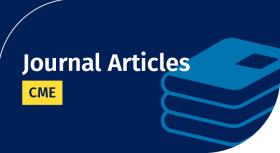
Summary for Clinicians: Clinical Practice Guideline for the Treatment of Systemic Sclerosis–associated Interstitial Lung Disease
An evidence-based guideline for the treatment of patients with systemic sclerosis–associated interstitial lung disease (SSc-ILD) was created in 2023 by a panel of multidisciplinary experts.
Systematic literature reviews were performed for the following therapies: cyclophosphamide, mycophenolate, rituximab, tocilizumab, nintedanib, combination of nintedanib plus mycophenolate, pirfenidone, and combination of pirfenidone plus mycophenolate.
The purpose of this article is to provide a concise summary for clinicians with key points about the treatment recommendations from the guideline to facilitate their implementation within the context of patient preferences, and it is not intended to represent a standard of care for patients with SSc-ILD.
Target Audience
Pulmonologists, critical care specialists, translational researchers, and clinicians
Learning Objectives
At the conclusion of this activity, learners should be able to:
- Describe categories of medications used to treat systemic sclerosis–associated interstitial lung disease (SSc-ILD)
- Identify the risks and benefits of different treatments for SSc-IL
- Incorporate the recommendations in this guideline into existing treatment strategies for the management of individual patients with SSc-ILD
Accreditation Statement
The American Thoracic Society is accredited by the Accreditation Council for Continuing Medical Education to provide continuing medical education for physicians.
Disclosure Declaration
Article Authorship Disclosures (as submitted to the ATS prior to article publication date)
Tanzib Hossain, M.D., M.S. (New York University Langone Health, New York, NY, USA) reported no relevant financial relationships with ineligible companies.
Sydney B. Montesi, M.D. (Massachusetts General Hospital, Boston, MA, USA) reported grants or contracts through the NIH, ATS, and National Scleroderma Foundation; personal fees from Wolters Kluwer, Roche, DevPro Biopharma, Gilead, APIE Therapeutics, and Cowen; other relevant financial relationships with Merck, UT Tyvaso, Boehringer Ingelheim, Pliant Therapeutics, and Three Lakes Foundation.
Elizabeth R. Volkmann, M.D., M.S. (University of California, Los Angeles, Los Angeles, CA, USA) reported grants or contracts from NIH/NHLBI, Boehringer Ingelheim, Kadmon, Horizon, Corbus, Forbius, and Prometheus and personal fees from Roche, GSK, CSL Behring, and Boehringer Ingelheim.
Carey C. Thomson, M.D., M.P.H (Mt. Auburn Hospital, Cambridge, MA, USA) reported grants or contracts from NIH, American Cancer Society, royalties or licenses or licenses from UpToDate, and personal fees from Median Technology and Springer.
Joseph K. Ruminjo, M.D. (American Thoracic Society, New York, NY, USA) reported no relevant financial relationships with ineligible companies.
Richard M. Silver, M.D. (Medical University of South Carolina, Charleston, SC, USA) reported grant support for research on lung fibrosis from Boehringer Ingelheim.
Marya Ghazipura, Ph.D., M.S., M.Phil. (New York University Langone Health, New York, NY, USA) reported no relevant financial relationships with ineligible companies.
Ganesh Raghu, M.D. (University of Washington Medical Center, Seattle, WA, USA) reported grants or contracts from NIH; royalties or licenses from UpToDate, consulting fees from Boehringer Ingelheim and Fibrogen, and other relevant relationships with Avalyn, American Thoracic Society, Pulmonary Fibrosis Foundation, Bellerophan, BMS, Fibrogen, Nitto, Novartis, Roche-Hoffman, and Veracyte.
Off-Label Usage Disclosure
The authors report off-label use of cyclophosphamide, mycophenolate, rituximab, and pirfenidone.
Disclosures of AnnalsATS CME Planners
The Annals of the American Thoracic Society (AnnalsATS) original research, commentaries, reviews, and educational content of interest to clinicians and clinical investigators in pediatric and adult pulmonary and sleep medicine and medical critical care. The scope of the journal encompasses content that is applicable to clinical practice, the formative and continuing education of clinical specialists, and the advancement of public health.
The publication of articles that meet these goals by itself is only one step in a multi-step process for the translation of evidence-based improvements in are to clinical practice. Testing for CME credit is designed to function as a next step in the process. This is accomplished through a series of questions written by the author(s) to test that readers have the tools needed to translate recommendations for diagnostic and therapeutic clinical care into clinical practice. Members of the AnnalsATS editorial board review these questions and edit these questions for clarity, educational content, and the quality of the evidence supporting the response to the question.
AnnalsATS CME Planners
Margaret M. Hayes, M.D.
Harvard Medical School, Boston MA, USA
Dr. Hayes reported receiving payments as an author for a chapter on heliox for UpToDate.
Caroline Okorie, M.D., M.P.H.
Stanford University School of Medicine, Stanford CA, USA
Dr. Okorie reported no financial relationships with ineligible companies.
Instructions to Receive Credit
To receive credit for this journal article:
- Read the journal article. Keep track of how long it takes you to read it.
- Once you open the article, the Post-Test becomes available. After reading the article, answer the post-test questions. You must answer all questions correctly to earn credit. You may take the test as many times as you like.
- Once you pass the Post-Test, the Evaluation becomes available. Answer all the evaluation questions.
- Once you complete the evaluation, select the amount of credit to receive based on the time it took you to read the article.
- You can view, save and print your Certificate by pressing the Certificate button.
- To review the credits you've earned in this system and reprint certificates, go to the My Learning drop-down list. Then select Transcript.
Available Credit
- 1.00 AMA PRA Category 1 Credit(s)™The American Thoracic Society designates this for a maximum of 1.00 AMA PRA Category 1 Credit(s)™. Physicians should claim only the credit commensurate with the extent of their participation in the activity.
- 1.00 Participation

 Facebook
Facebook X
X LinkedIn
LinkedIn Forward
Forward